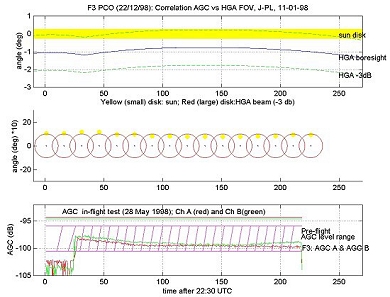Huygens 3rd Probe Checkout
The third checkout of ESA's Huygens probe (F3) began on 21 December 1998 at 22:20 UTC and was completed at 02:35 UTC on the morning of 22 December. As planned, the checkout occurred outside ground station visibility. However, a Deep-Space Network station pass an hour later allowed the Huygens flight control team at the Agency's control centre in Darmstadt (D) to monitor some vital engineering data channelled through the Cassini orbiter.
The full data produced by Huygens during the checkout was recorded on Cassini's solid-state recorders, ready for scheduled transmission to the ground on 28 December, using the Cassini High-Gain Antenna (HGA) for the first time since launch.
 |
|
Figure 1. High Gain Antenna |
On 28 December, after the successful re-orientation of the Cassini/Huygens spacecraft to point its HGA to Earth, the Huygens checkout data were successfully downlinked at the 142 kbit/s data rate via a Deep Space Network station in Goldstone, California. The link was excellent and all Huygens data were recovered at JPL, Pasadena, California, and transferred to the Huygens Probe Operations Centre (HPOC) at ESOC at the end of the day.
A preliminary evaluation of the data was performed by both the Huygens Flight Operations Team at ESOC and by the Huygens Principal Investigator Teams at their home institutes. All Probe system parameters were nominal and the six payload teams reported that their experiment performed as expected.
Preliminary analysis of the data on 22 December had already shown that all power relays had turned back to the nominal OFF status and that the Power Control Distribution Unit (PCDU) temperatures had decreased at the nominal rate. An estimation of the maximum temperature reached by the PCDU during the check-out indicated that an increase of 27 to 30 °C had occurred - in line with the expected behaviour of the Probe.
Because the third checkout was executed in the usual HGA-to-Sun attitude (at ~1.6 AU), the solar radio noise effect was observed again in the Huygens receiver Automatic Gain Control (AGC) signals with, however, a reduced level compared to the F1 and F2 checkouts (which were performed at 1 AU and 0.6 AU respectively). This expected behaviour confirms the understanding of the Huygens receiver performance, in presence of radio noise, that was reached after the special AGC in-flight test executed on 28 May 1998.
This successfully completed the first activity of a month of Cassini/Huygens instrument check-out activities, which you can follow throughout the coming weeks on JPL's Cassini web page.

